Content [show]
Tradescantia is a common houseplant. Although in its homeland, America, it is a common weed. In our country, Tradescantia is very much loved by gardeners for its excellent decorative properties and unpretentiousness. Home care: what is it?
If earlier the plant had just a tremendous success and could be seen almost everywhere, now the fashion for this gorgeous ampelous plant has passed. But for novice florists, breeding Tradescantia is a great opportunity to try your hand.
What does the plant look like?
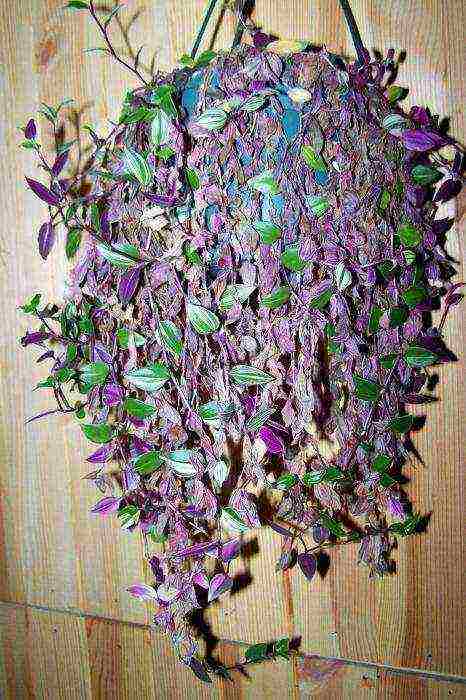 Tradescantia, home care for which we will consider in detail today, looks very beautiful. The long, bright green stems can grow up to one meter in length. And if the pot with the plant is placed on a high shelf, then the resulting waterfall of greenery will become the highlight of the interior of the room.
Tradescantia, home care for which we will consider in detail today, looks very beautiful. The long, bright green stems can grow up to one meter in length. And if the pot with the plant is placed on a high shelf, then the resulting waterfall of greenery will become the highlight of the interior of the room.
The leaves of the plant grow up to 15 centimeters in length. They are very thin and alternate on the stem. Foliage can be either pure green or variegated. Quite a few species boast reddish, white and yellow stripes on their leaves.
But the plant blooms discreetly. Tradescantia flowers are very small and can have white, pink or purple hues. They open early, while the sun has not yet begun to shine in full force. The buds are closed during the day. True, on a cloudy day, Tradescantia leaves the buds open until evening.
Plant care
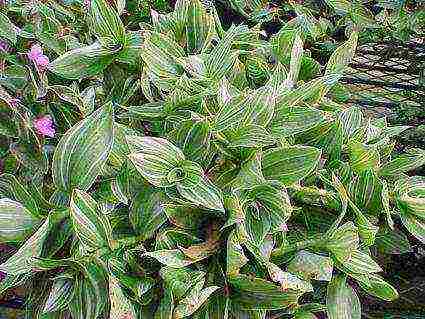 Tradescantia is a flower that belongs to ampelous plants, it has very fragile graceful stems hanging over a beautiful waterfall. Although the plant belongs to perennials, it is recommended to rejuvenate it about once every 2 years, and sometimes this period is reduced to one year. The fact is that as it grows, the lower leaves dry out and the stem is completely bare. It doesn't look too pretty, so the plant needs a transplant. We will talk about how you can propagate Tradescantia a little later.
Tradescantia is a flower that belongs to ampelous plants, it has very fragile graceful stems hanging over a beautiful waterfall. Although the plant belongs to perennials, it is recommended to rejuvenate it about once every 2 years, and sometimes this period is reduced to one year. The fact is that as it grows, the lower leaves dry out and the stem is completely bare. It doesn't look too pretty, so the plant needs a transplant. We will talk about how you can propagate Tradescantia a little later.
Temperature regime
The Tradescantia flower, which is not too difficult to care for, is also undemanding to the ambient temperature. It feels great in both cool and warm rooms. Of course, the plant will not tolerate excessive hypothermia, so the lower temperature bar is +10 degrees. But white-flowered Tradescantia grows well even at +7. In addition, the flower loves the flow of fresh air and is not at all afraid of drafts.
Light mode
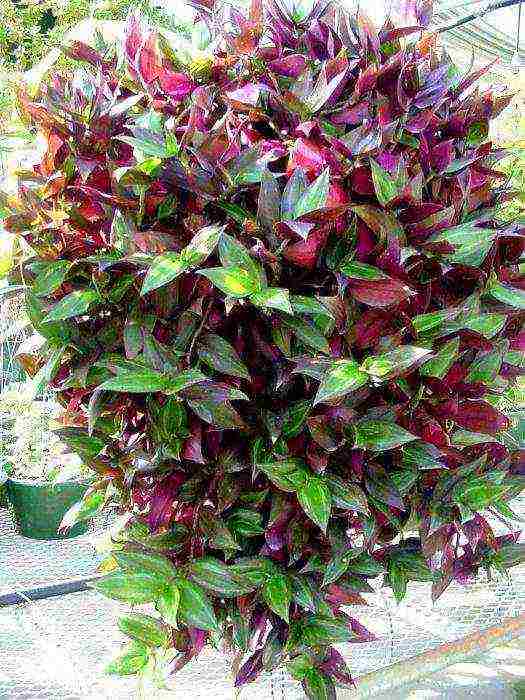 Tradescantia is a flower, although it is unpretentious to care for, but it grows better in good light. If the bulk of home flowers need shading, then this green cascade prefers to receive direct sunlight. Partial shade also does not prevent the plant from fully manifesting its decorative properties. But there are some nuances here. Variegated Tradescantia varieties acquire a brighter color in a well-lit room, while the monochromatic leaves of the plant become faded under the constant rays of the sun. Plants placed in partial shade again acquire a juicy green hue.
Tradescantia is a flower, although it is unpretentious to care for, but it grows better in good light. If the bulk of home flowers need shading, then this green cascade prefers to receive direct sunlight. Partial shade also does not prevent the plant from fully manifesting its decorative properties. But there are some nuances here. Variegated Tradescantia varieties acquire a brighter color in a well-lit room, while the monochromatic leaves of the plant become faded under the constant rays of the sun. Plants placed in partial shade again acquire a juicy green hue.
Watering
Tradescantia, for which we are now considering home care, loves water very much. During the entire active growing season, which lasts from spring to autumn, it requires constant watering. It is simply impossible to fill it. The only "but" - the earthen lump should always be wet, but stagnation of water should not be allowed.
In the winter months, the plant is watered less, but still the ground should always remain slightly damp. The water that will be used for this purpose must be defended.
Feeding Tradescantia
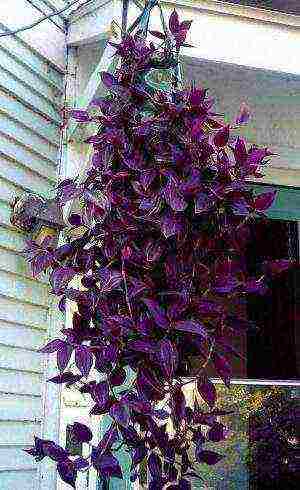 During spring and all summer, the plant must be fertilized, observing a frequency of two weeks. With the onset of winter, feeding is carried out once within a month and a half. Any complex or organic compound can be used as a fertilizer. But for variegated varieties, specialized fertilizers should be purchased. Top dressing must be combined with watering.
During spring and all summer, the plant must be fertilized, observing a frequency of two weeks. With the onset of winter, feeding is carried out once within a month and a half. Any complex or organic compound can be used as a fertilizer. But for variegated varieties, specialized fertilizers should be purchased. Top dressing must be combined with watering.
Landing: some subtleties
Tradescantia, planting and caring for which is the topic of our conversation, is an undemanding plant. But if the goal is to get a really great sample, then there are some rules to follow. You can take ordinary soil as a planting substrate, but then the plant is not at all insured against various unpleasant situations. Indeed, various pests can live in the ground. Sometimes Tradescantia is literally occupied by black mosquitoes. You can cope with this only by using chemicals. And in order not to complicate the care of the plant, it is best to use a ready-made flower mixture. If it is not possible to buy one, then you can compose the soil yourself. You need to take leaf humus, turf and sand in a 2: 1: 1 ratio. Beforehand, each component must be thoroughly calcined in the oven.

Air humidity level
There is no need to spray Tradescantia all the time, but it won't get any worse from periodic spraying. This is especially true in winter, when the heating season begins. You can sprinkle the flower with settled water several times during the day. As you can see, Tradescantia is very unpretentious. Home care is quite simple. Now it's time to get acquainted with the plant propagation options.
Plant propagation
The flower reproduces very simply, and most importantly - quickly. The main method - cuttings - can be used throughout the year. But in winter, when daylight hours are significantly reduced, the process of plant rooting is delayed. In the rest of the year, cut cuttings give roots after two weeks. The planting substrate is composed of the following components: compost soil, sand and humus (in a ratio of 1: 1: 1). After the plant takes root, it will take no more than a month for it to regain its decorative effect.
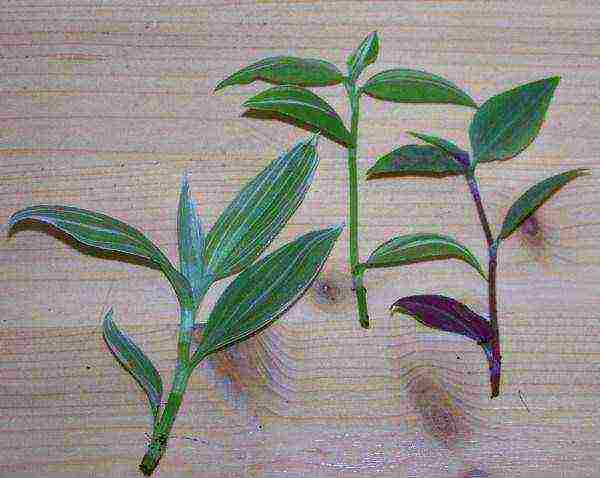
Tradescantia, the reproduction of which is planned to be carried out, should not be too "old". For cuttings, it is necessary to choose young shoots. Cuttings intended for rooting must have at least 6 sections.
Flower propagation can be carried out using seeds. This option is best for spring. You can start planting seeds as early as March using window mini-greenhouses. A combination of peat and sand in a 1: 1 ratio is recommended as a planting substrate.The optimum temperature for seed germination is +20 degrees. The ground should be periodically moistened using a spray bottle and ventilated. When shoots appear, they need to be sprayed quite often. Tradescantia, grown from seed, bloom during the third year of life.
Diseases and pests
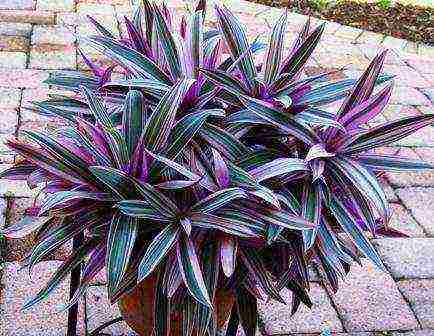 Tradescantia flower (you see the photo) is very fond of various parasites. Scabbard, aphid, thrips, spider mite - this is a list of the most common pests on the plant.
Tradescantia flower (you see the photo) is very fond of various parasites. Scabbard, aphid, thrips, spider mite - this is a list of the most common pests on the plant.
Scabbards can be dealt with using soap or alcohol solutions. It is necessary to wet a cloth and remove insects. Such procedures are carried out several times a week, but not less than four. If the plant is too badly affected, then it must be treated with drugs such as Actellik, Karbofos or Fufanon.
Aphids damage mainly young shoots. At the same time, the leaves lose their color and fall off. Aphid milk becomes an excellent basis for a sooty fungus, which does not allow the process of photosynthesis to go through fully. Spraying with soap solutions will save the plant from aphids, since the soap covers the pests and does not allow them to breathe. Fitoverm and the same Aktellik will help in the fight against spider mites.
We hope that our article helped you get answers to your questions. And now your favorite will delight you with her beauty.
Tradescantia is a favorite houseplant for flower growers, valued for its shade tolerance, originality of stems and leaves, and extreme simplicity of reproduction. Stems are thin, branched, capable of growing up to several meters in length. All types of tradescantia grow well, care for which at home is extremely simple.
Tradescantia: types and varieties
This exotic originates from the tropical forests of South America, where, thanks to the ability of the shoots to quickly root, it has turned into a weed that forms whole thickets. All types of Tradescantia are suitable for indoor floriculture.
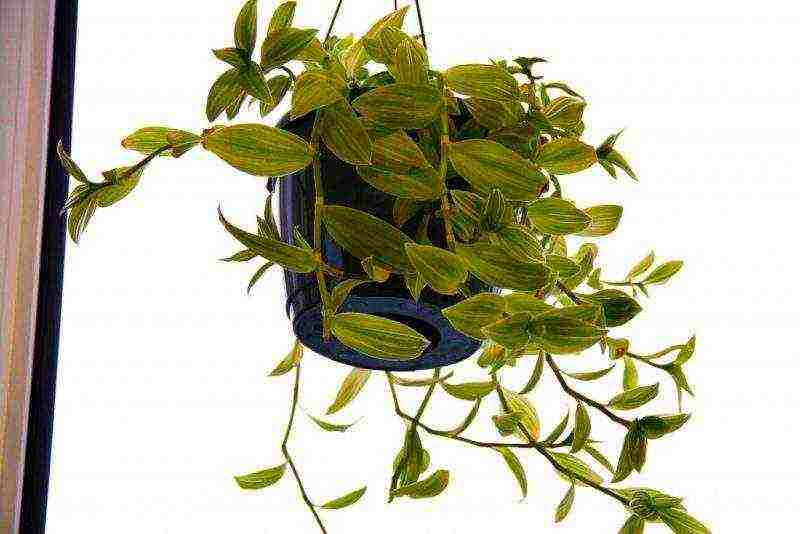
They differ mainly in the color and shape of the leaves, which can be light green, dark, double, violet-green. The leaves of variegated Tradescantia varieties are decorated with numerous white stripes. In good light, the contrast between them and the green parts increases, which makes the flower even more decorative.
Types of tradescantia:
- More common white-flowered tradescantia with bright green leaves, decorated with two silvery longitudinal stripes. The underside of the leaf has a purple hue.
- Myrtle leaf tradescantia has bright silver flat against the background of a dark green leaf, the lower part of which is deep purple.
- Tradescantia Zebrina, as you might guess, is also loved for the decorative stripes on the leaves. A distinctive feature is lilac stripes on a light green background.
- Tradescantia purple differs in a monotonous purple color of the leaves. The bush itself is slightly larger and fleshy than other species.
- Virginia Tradescantia does not stand out with striped patterns, but it has high cold resistance. In the southern regions of Russia, it can be grown even outdoors. The leaves are green, thin, elongated, the flowers are white, blue, pink, purple. From June to late autumn, it can bloom in a favorable climate.
Home care
The indoor flower Tradescantia is very unpretentious in comparison with other plants. Observance of some of the nuances allows you to grow a beautiful branched bush.
Temperature features, lighting, humidity
The optimum temperature for the development of tradescantia is 20-24 degrees. In winter, she does not need a cold wintering, but if it is possible to provide her with coolness in the region of 16-18 degrees, she will thank her with a powerful wave of growth in early March.
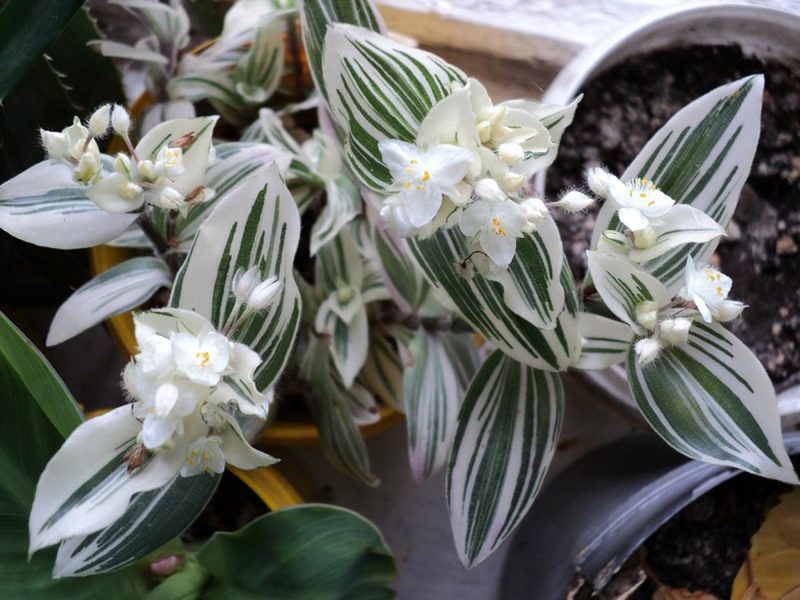
Tradescantia grow well in any light: from direct sunlight to diffused light on northern windows.But specimens that receive more light look more decorative, especially the double and striped varieties. It is not worth it, perhaps, to place the pots in the back of the room, where there is too little light for any plants.
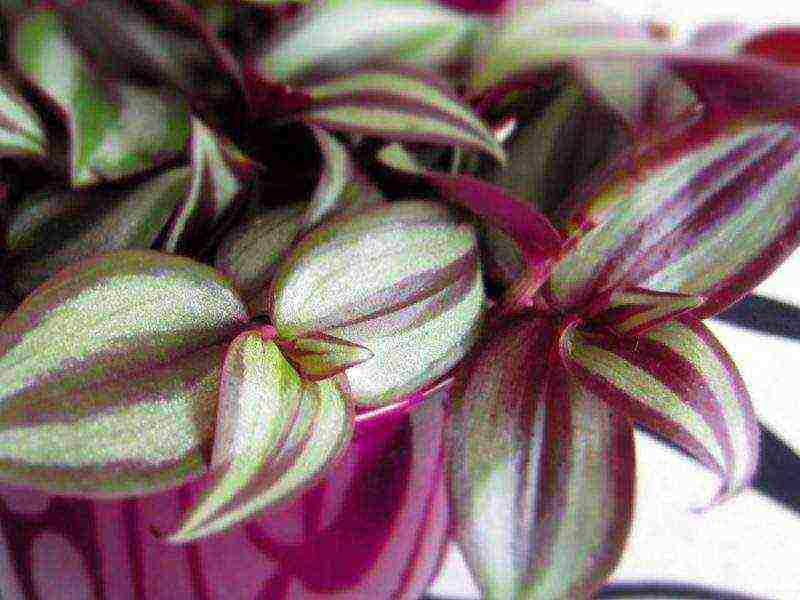
Additional air humidification has a positive effect on the growth of tradescantia. Many people prefer to spray green pets with a spray bottle, but this measure has a weak effect, since the moisture evaporates quickly. Other growers arrange containers with water around the plants, but in order for the evaporation to somehow affect the growth of the flower, they need to force most of the windowsill. The best solution is to place the tradescantia among other plants: green leaves give off a lot of water during the growing season. Additionally, moss can be sown in shallow bowls, the spores of which are in any flower shop, just remember to water it abundantly.
Soil requirements
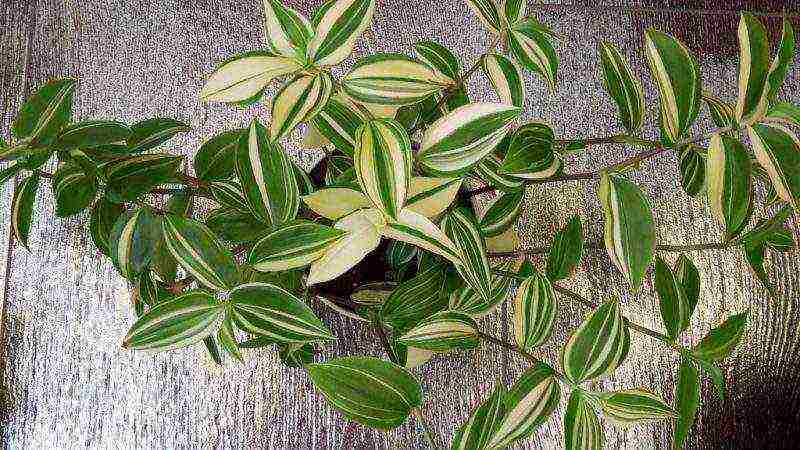
Tradescantia can adapt to any type of substrate other than an overly heavy and watertight substrate. It grows best in a mixture made up of 2 parts of humus earth, 2 parts of leaf and 1 part of coarse sand. Purchased universal soil for indoor plants, which should be diluted with ordinary soil from a vegetable garden, garden or forest, is also suitable. If the substrate does not seem airy enough, you can pour a small amount of vermiculite, perlite, river sand or sawdust into it.
Watering and feeding
The plant loves abundant watering. Florists often get the impression that she is insatiable for water. For safety reasons, plant it in pots with a drainage hole and a layer of pebbles, stones or broken pottery at the bottom. It is convenient to use the planter hanging on the window. Watering can be slightly reduced in winter, but the top layer of the earth should not dry out in any case.
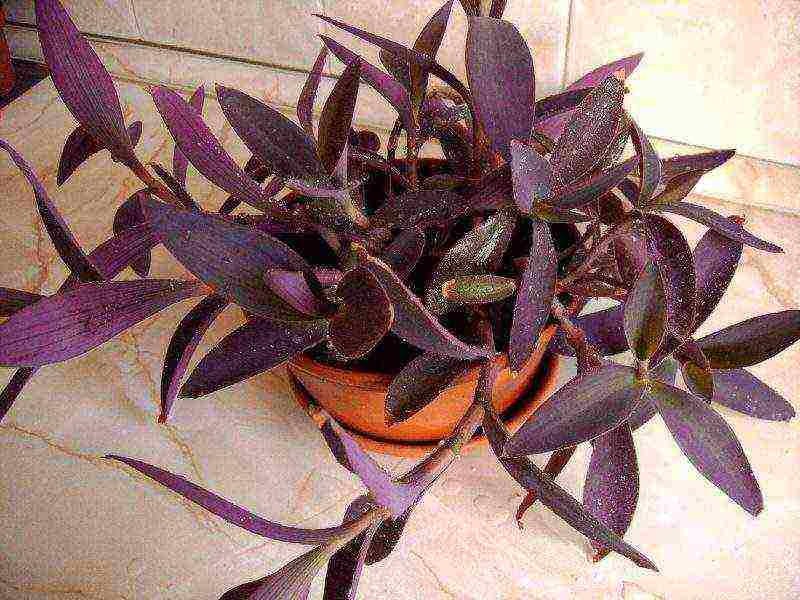
They respond positively to feeding during the period of active growth. Fertilization significantly accelerates the growth of green mass, increases the chances of flowering. You can water with solutions of universal fertilizers for indoor plants or tinctures of bird droppings. The response is also observed when applying mineral fertilizers, which are diluted according to the instructions on the package. The ratio of nitrogen, phosphorus and potassium when preparing the solution should be approximately the same. In the spring, you can add a little more nitrogen.
Important! Do not overfill the plant, as it has an increased tendency to decay!
Bloom
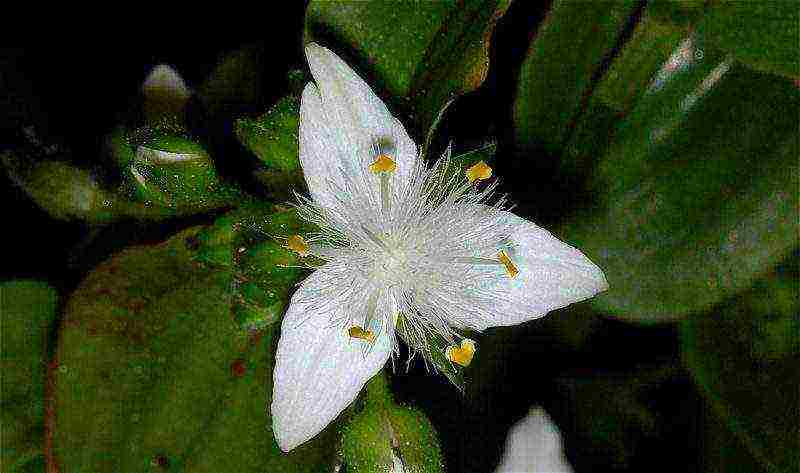
With good care, the plant almost always blooms outdoors and half of the time at home. Flowers can be white, purple, blue, pink. For the plant to give buds, it needs enough light and top dressing every 1-2 months.
Transplant and pruning
Transplanting Tradescantia is advisable only if the roots are tightly braided with an earthen lump, which makes it dry quickly. The new pot should be several centimeters larger than the previous one.
Old, overgrown tradescantia often shed leaves over most of the shoot length. As a result, only the ends of the branches remain leafy. In such cases, they are cut by 70-90%, and the resulting cuttings are cut into fragments 5-10 cm long, and put on rooting. The pruned bush gives young shoots from the remaining stumps. If the result does not suit the grower, then new specimens can be grown from rooted cuttings.
Flower propagation
The easiest way to propagate is to put cuttings on rooting in water. If desired, rooting can be done in sand, vermiculite, perlite and even light soil. To increase the chances of success, the container with the cuttings can be covered with a bag or a transparent plastic cup, but even without this, the proportion of rooted cuttings usually reaches 95-100%. It is better to plant 2-3 plants in a pot together.
It is much less often propagated by seeds.Experimental lovers can sow seeds in shallow containers with sandy soil, lightly sprinkle them, spray from a spray bottle and cover with a plastic bag. Seedlings can be seen in 3-4 weeks. This is followed by the standard procedure for accustoming seedlings to dry room air: small holes are made in polyethylene every day or existing ones are expanded. After 1-2 weeks, the film can be removed completely.
Pests and diseases - how to treat?
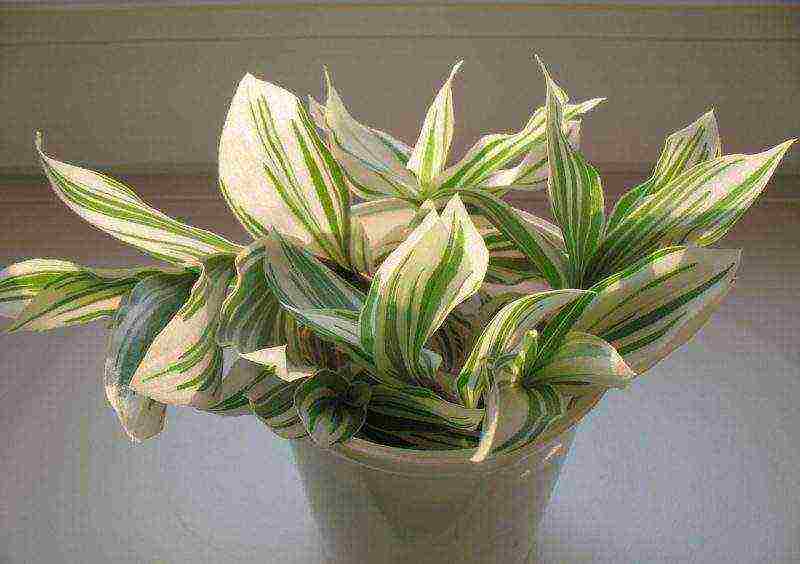
Pests usually have little interest in Tradescantia. Sometimes a red spider mite, aphids, and occasionally a scale insect settle on it.
| Aphid | Aphids are easy to remove with any insecticide. |
| Mite. This terrible pest looks like a harmless small dot on the surface of a leaf. With an increase in air humidity, it begins to move through the plant. | If the tick does not take a liking to the plant too tightly, then the insectoacaricide Fitoverm will help. Only it needs to be diluted in 1.5-2 times higher concentration than recommended on the package. 7-9 days after the first treatment, the second is carried out. If the tick no longer appears, then with some degree of probability it was successfully defeated. But it happens that he comes back. |
| Basal and root rot. | The best prevention is planting a plant in light, moisture-permeable soil. |
Important! Tick eggs are viable for five years!
What problems can you face?
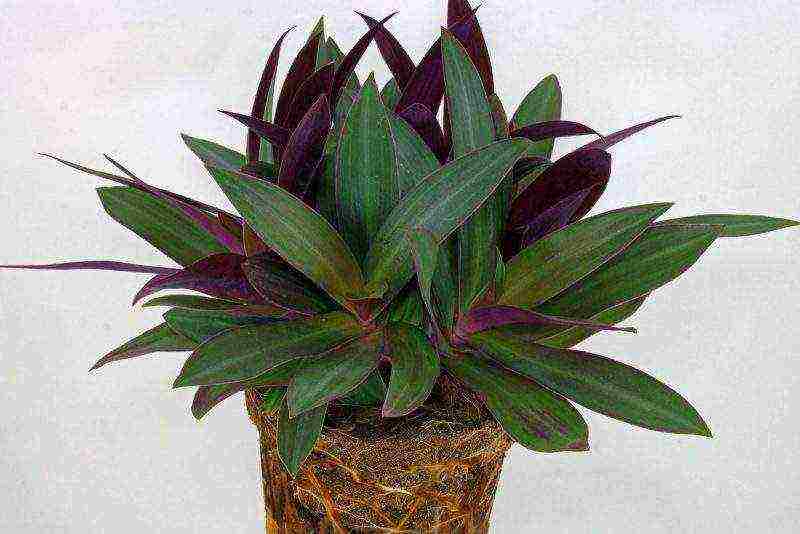
Growing a plant, you can face some problems:
- If the tips of the leaves turn brown and dry out, the most likely cause is low air humidity.
- Sluggish stems for no apparent reason and brownish-yellowish spots on the leaves indicate either insufficient watering or hypothermia of the roots from too cold water. To prevent this from happening, the water drawn from the tap is defended at room temperature.
- With a lack of light, the stems become excessively stretched, and the internodes become long. It is important to remember that in the depths of the rooms the lighting is so low that it is unacceptable for plants. You need to place flowers on the windowsills.
- The softening and decay of the trunk at the root collar speaks of the bay. Such a plant is difficult to save, since by the time the symptoms appear, the root system is already in a deplorable state. But you can take a stalk, root it and grow a new specimen. If you still want to try to leave the affected plant, then you need to change the soil and cut off the rotten roots.
In general, Tradescantia is easy to grow without any difficulty. This is probably the secret of her popularity.
Tradescantia is familiar to almost everyone: until recently, it was an adornment of any room. And schools, kindergartens, hospitals, were simply crammed with these plants - in few institutions pots with hanging multi-colored shoots did not stand on the shelves.
In our time, new, picturesque varieties and species have appeared that are in demand among modern flower growers due to their unpretentiousness and ease of breeding. Amateur flower growers call it ‘woman’s gossip’ because of the long twigs, which are tangled so that it is difficult to make out where this or that shoot originates.
Description of tradescantia
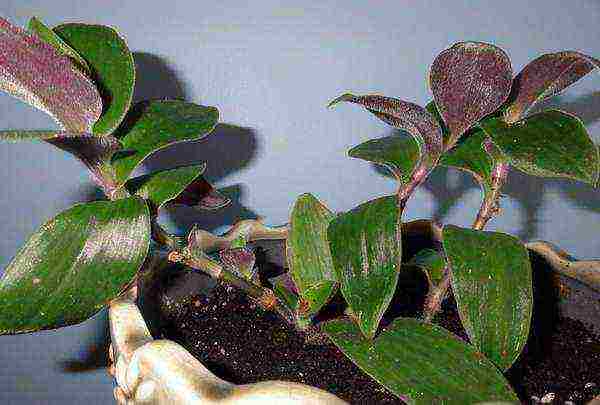
Flower tradescantia reproduction planting and care at home photo
The genus Tradescantia (Tradescantia) consists of about 60 species of perennial herbaceous plants, originating from the humid tropics and subtropical forests. Some of them grow in arid regions. The main decoration is considered to be amazing leaves growing on long stems with multiple branches. Their color ranges from light green to blueberry and depends on lighting and temperature. Some varieties have original stripes on the leaves. In our climate, they are grown both in the home and in flower beds.
Due to the peculiarity of the branches to lodging, it is used as an ampelous culture.At first, young stems grow straight up, but soon droop, unable to withstand their own weight. Therefore, they look more respectable in wall pots, on the upper shelves of furniture. In natural conditions, commeline plants grow on the ground, with the help of sprawling, rooting branches, they capture uninhabited places.
Commeline are known for hanging stems with alternate leaves that completely hug the trunk at the junctions. To get out, side shoots often have to break the cover leaf. The veins on the leaves diverge in parallel lines. But the main distinguishing features are associated with the flower. Three petals of white, pink, lilac or purple are enclosed in greenish, loose sepals and live for only a couple of days.
Flowering is unattractive, so it is recommended to pick off the buds. They also tend to grow continuously, which is dependent on nutrition, watering and temperature. The inner rhythm of Tradescantia does not exist.
On the hanging branches, there are barely noticeable root rudiments, which, when in contact with a moist soil substrate, immediately increase in size and cling to the soil, which is successfully used for breeding.
Home care for tradescantia
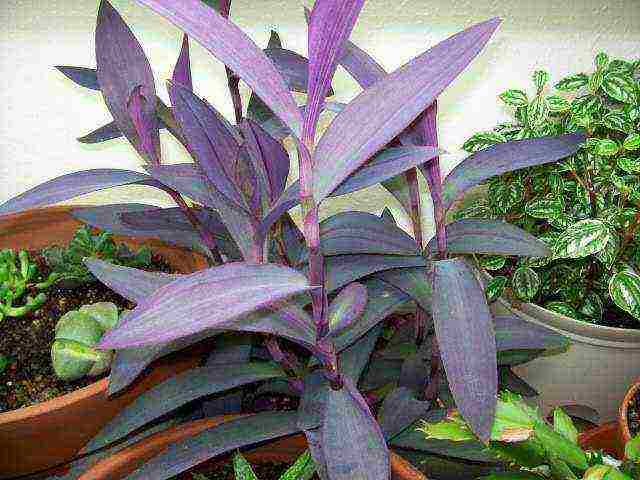
Tradescantia indoor care and reproduction
The correct conditions for keeping tradescantia will ensure its full development, abundant flowering, and the formation of green mass. The beauty will delight its owner, giving a positive charge of energy and great mood. I am glad that there are almost no care requirements and it is very simple to comply with them.
If the plant lives in the same pot for a long time- the roots no longer cope with the task of providing nutrition for the green mass - partial drying of the leaves begins and the lower part of the stem is exposed, which later dries up: the crown parts hang from the pot on elongated, almost naked, shoots. In this case, grafting is urgently required to obtain young bushes.
Basically, all Tradescantia love rooms with high humidity and abundant watering.... They can leave a small amount of water in the pan for a short time. Water it abundantly, without waiting for the earthen coma to dry, reducing the volume of water only when the room temperature drops. Only some desert species require soil drying between waterings.
The more abundantly Tradescantia is fertilized, the faster they grow.... Top dressing is carried out in the phase of active growth. Fertilizers can be any - organic or mineral.
Tradescantia is usually not transplanted, with the exception of especially valuable specimens, which are transferred into a large bowl with the addition of fresh earth. Ordinary plants are simply renewed using cuttings, because over time, the lower parts of the stem become bare and the flowers take on an ugly appearance.
Growing tradescantia from cuttings

Growing tradescantia from cuttings photo
Even the most inexperienced flower lover can propagate Tradescantia.
- Cuttings 10 cm long are taken from adult specimens.
- The leaves on the lower internodes are removed.
- Several pieces are planted in a pot at once and watered abundantly.
- To speed up the process, you can cover the pot of cuttings with a jar. When new kidneys appear, the jar is removed.
- Cuttings can be rooted in water, with further planting in the ground.
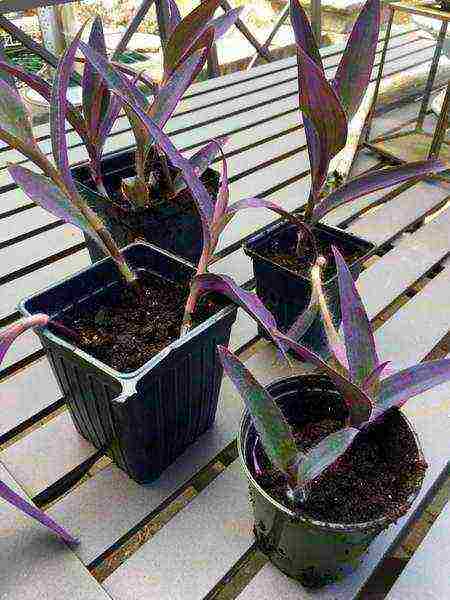
Cuttings of tradescantia take root within a few days.
Tradescantia can be rooted even with a very small piece of stem with a pair of leaves. It is buried in the lower part of the soil mixture - roots and shoots grow from the internode at the same time. If you cover the stalk with a transparent jar, the plant will release new shoots faster.

Cuttings of tradescantia take root well in water and after a week they can be planted in the ground.
One of the British florists placed the sprout in a glass bottle and closed it with a cork. He watered the plant only once.And this flower in a vessel without earth has been growing for over 50 years, forming a closed ecosystem. Amazing, right?
For garden forms, the division of the bush and seed reproduction are relevant. Some species are self-seeding. When transplanting, the roots are pruned a little and the bush is dismembered into parts. The plant quickly recovers and blooms.
Landing Tradescantia
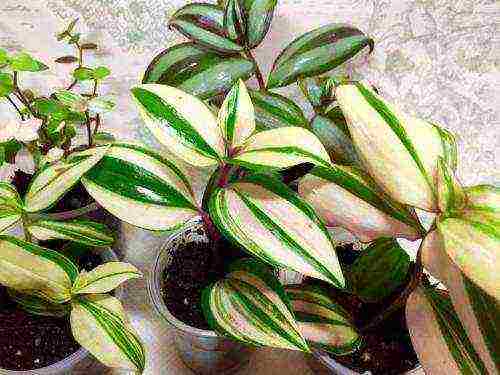
Tradescantia care and planting photo
Planting Tradescantia is simple - you need to prepare a nutritious soil. The nutrient mixture is best suited for orchids: the substrate is quite loose, has good drainage properties, and contains all the substances the plant needs.
To plant Tradescantia:
- Fill the pot with substrate
- We make a recess for the cutting with the root system and place it there, sprinkle it with earth.
- If the stalk is without a root, just press it into the ground to a depth of 3-4 cm.
- Watering.
The planting of the Tradescantia is over! It remains to water on time and enjoy the rapid growth of the flower.
Tradescantia pests and diseases
Tradescantia is resistant to pest attacks and is less susceptible to disease. Nevertheless, you should take the necessary measures, noticing negative changes. The red mite sometimes settles on the back of young leaves. To avoid the appearance of pests, you can periodically water the soil in pots with a solution of tar soap.
If a large number of insects are found, the plant, along with the pot, is placed in a plastic bag and the flower itself, pots and soil are carefully treated with an insecticide. The bag should be tied with a knot and the plant should be left in it for 5 days. After that, the processing is repeated. Three times processing completely eliminates pests. The place where the pot was located should also be wiped with a napkin moistened with an insecticide solution to avoid re-infection.
Most varieties are loyal to the conditions - they tolerate a lack of light, nutrients, watering, air humidity, attention from the owner, although their appearance suffers.
Commelinaceae can be kept in hydroponic culture - their roots are quite resistant to lack of air. To maintain tradescantia at this content, you should provide nutrients by dissolving them in water. Such a solution is poured into the dishes where they are located.
Types of tradescantia with photos and names with descriptions
Tradescantia shaggy Tradescantia villosa
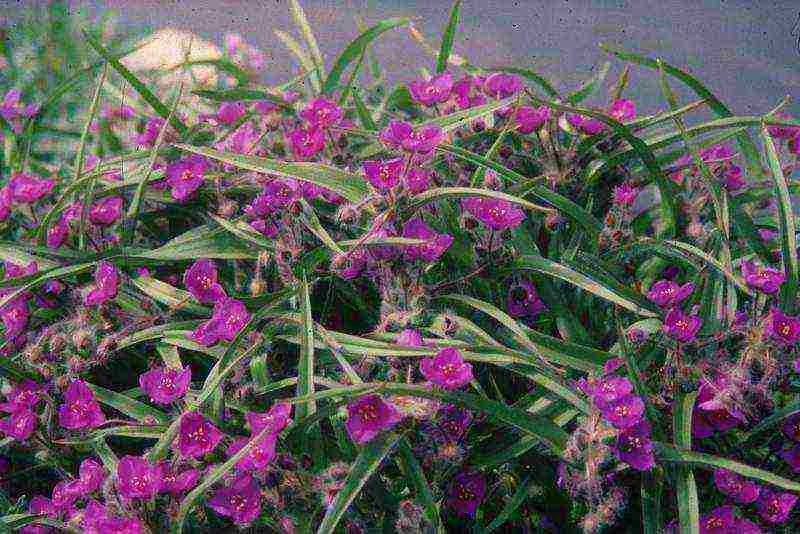
Tradescantia shaggy Tradescantia villosa photo
This tradescantia can be easily identified by the leaves covered with silvery pubescence. It is not entirely common: it is not only a very beautiful, but also a resistant plant that can easily tolerate drought. There are known examples when the furry Tradescantia lived without water for several weeks. With a lack of moisture, the leaves turn purple, lose their elasticity - as if the plant freezes. But as soon as a little water gets on the roots, it will come to life and bloom with amazing purple flowers. This flower feels good where other flowers cannot withstand heat and sun - on the windowsills of southern windows and, even next to central heating radiators. In the summer, you can plant it on the balcony.
White-flowered Tradescantia Tradescantia albiflora
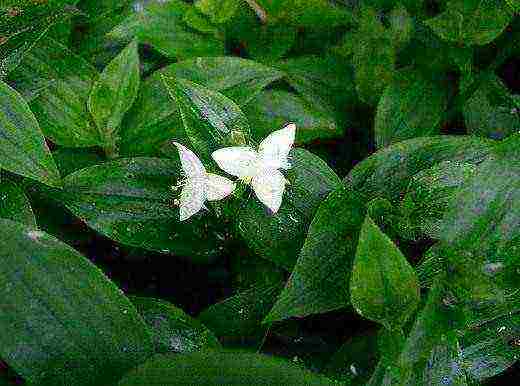
Tradescantia white-flowered Tradescantia albiflora photo planting and care
The stem of the plant is herbaceous, strongly branching. Its malachite leaves are sometimes slightly pubescent, and the flowers are white. In order for the bush to be more picturesque, the flowering shoots should be pinched, since the flowering is inconspicuous and depletes the plant. The most common form is with leaves speckled with irregular white stripes on a light emerald background. The shape of Laekensis differs from the previous one in pink stripes, while Tricolor has both white and pink stripes.
Tradescantia blossfeldiana
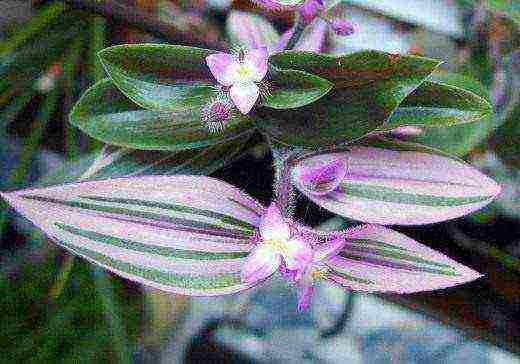
Tradescantia blossfeldiana Tradescantia blossfeldiana photo
This form has a few wide stripes of yellow and green.With a lack of lighting, inept grafting or pruning, beautiful stripes on the leaves can disappear irrevocably.
Tradescantia riverine Tradescantia fluminensis
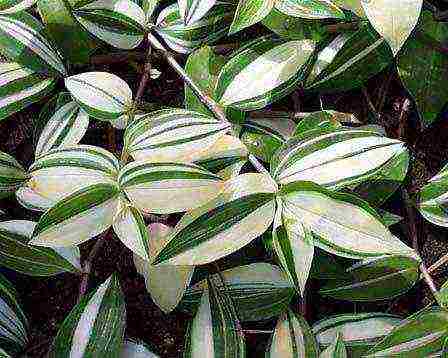
Tradescantia riverside Tradescantia fluminensis variegata photo
This species has frequent light yellow stripes. The creeping shoots of this species have a magnificent purple color with a greenish speck.
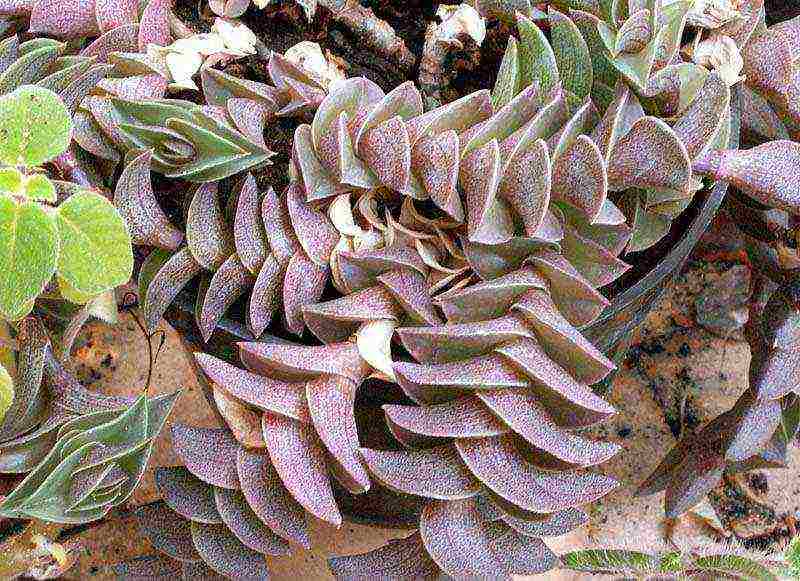
Tradescantia navicularis photo
A wonderful plant that forms clumps among thickets of cacti on clay soil. It can rightfully be considered a succulent - moisture is contained in all parts.
Tradescantia sillamontana

Tradescantia sillamontana Tradescantia sillamontana photo
She is literally shrouded in thick white felt - it is problematic to determine the real color of her sheet plates. Its stems grow vertically, and the leaves are arranged in a spiral. Bright pink flowers are especially spectacular against the background of whitish leaves.
Tradescantia virginiana
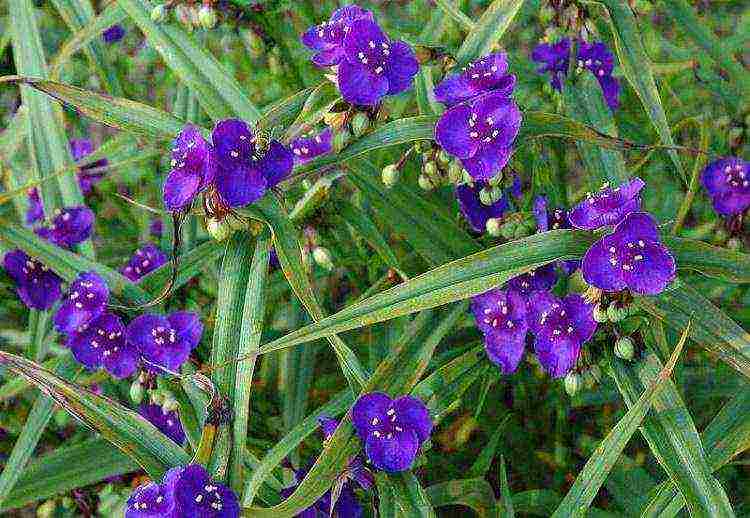
Tradescantia virginiana Tradescantia virginiana photo
It is successfully cultivated in private plots as a perennial plant. It has erect stems with ribbon-like leaf blades. Blooms with numerous flowers of pink, blue, collected by umbrellas. The fruit is a capsule with folding flaps.
Tradescantia andersoniana
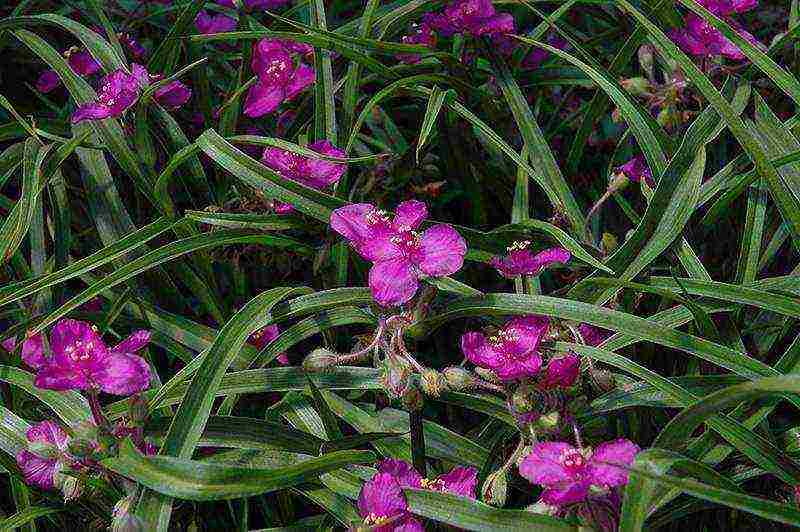
Tradescantia andersoniana photo
Abundantly flowering perennial for flower beds with a straight stem 35-75 cm high. It has many varieties.
Garden species of Tradescantia are easily bred by cuttings, seeds, dividing the bush. This operation is carried out at the beginning of the season, cutting the roots a little, after which the flowers quickly recover. Propagating by seeds, you can get copies that are completely different from the parent individual.
This inconspicuous flower has a number of positive qualities.
- The plant is able to cleanse the surrounding atmosphere from negative emissions: tobacco smoke, toxins that exude building materials and furniture.
- Neutralizes the electromagnetic field emitted by household appliances.
- It is actively used in folk medicine - heals wounds, stops bleeding, relieves inflammation, improves the condition of diabetics.
- Scientists have found a substance similar in quality to insulin in the juice of the Tradescantia variety Zebrina.
- Commeline phytoncides destroy viruses and microbes present in the room.
- Tradescantia humidifies the air, improving the microclimate.
- Pets, especially cats, love to eat juicy leaves. Aquarium fish, birds eat chopped leaves with pleasure.
- It is believed that Tradescantia cleans the energy field of the house, removes spoilage, the evil eye, and improves relationships between others. Great for all zodiac signs.
Tradescantia, one of the first representatives of the flora, traveled to space, traveling on a satellite. This beautiful and useful plant brings a lot of positive emotions to its owners.
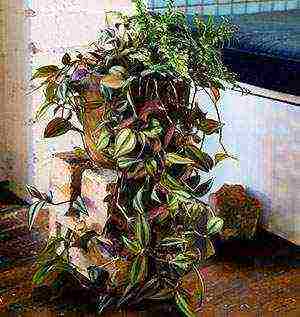 Unpretentious fast-growing tradescantia does not need to be introduced to lovers of indoor plants. Simple home care for Tradescantia, decorative foliage and frequent flowering are three main reasons why these herbaceous perennials have become regulars both indoors and in garden plots for many decades.
Unpretentious fast-growing tradescantia does not need to be introduced to lovers of indoor plants. Simple home care for Tradescantia, decorative foliage and frequent flowering are three main reasons why these herbaceous perennials have become regulars both indoors and in garden plots for many decades.
Small plants with predominantly creeping stems are found in nature on the American continent, where they inhabit regions from temperate latitudes to the tropics. Tradescantia have adapted well to their habitat. In arid regions, you can see plants with dense leaves, the pile on which does not allow precious moisture to evaporate. In humid places, species with juicy stems and such bright glossy foliage are found.
The simplicity of room tradescantia, a variety of decorative species and varieties attract the attention of both beginners and experienced florists. And more recently, garden tradescantia has appeared in Russian gardens, which does not differ from domestic relatives either in attractiveness or responsiveness to care.
Home care for tradescantia
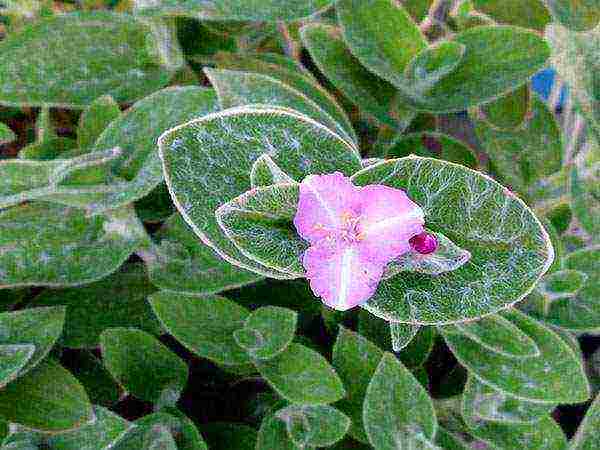 Requirements for the conditions of keeping tradescantia differ depending on their natural habitat. Pubescent plants with dense and thick foliage are more hardy. They tolerate direct sunlight better and are less dependent on watering frequency.
Requirements for the conditions of keeping tradescantia differ depending on their natural habitat. Pubescent plants with dense and thick foliage are more hardy. They tolerate direct sunlight better and are less dependent on watering frequency.
Indoor tradescantia with smooth thin leaves love partial shade and grow best in moderately moist soil. At the same time, variegated varieties are more demanding on lighting. Under the bright sun, they turn pale, and in the shade they risk losing their pattern and becoming completely green.
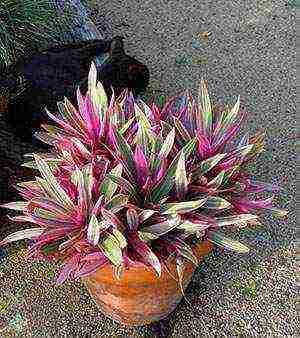 It is best for a room tradescantia, as in the photo, to find a place on the east or west window. On the south side, the plant will need shading, and on the north, there is a danger:
It is best for a room tradescantia, as in the photo, to find a place on the east or west window. On the south side, the plant will need shading, and on the north, there is a danger:
- excessive stretching of shoots;
- reduction of leaves;
- lack of flowering;
- rapid loss of decorativeness.
Most species are thermophilic, but in the summer months it is useful to carry Tradescantia to the balcony, garden or loggia, having previously protected the pot from the scorching sun and drafts.
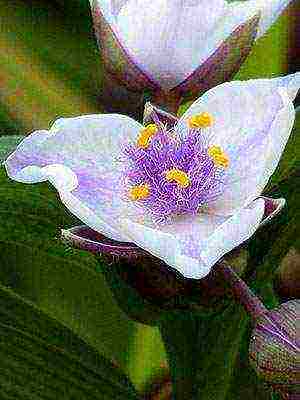 The comfortable temperature for Tradescantia is from 20 to 25 ° C in summer, and a few degrees lower in winter. Although a cool hibernation is preferable, in many cases, indoor tradescantia grows well without seasonal changes in conditions. Air becomes critically cold for plants at a temperature of 10–12 ° C.
The comfortable temperature for Tradescantia is from 20 to 25 ° C in summer, and a few degrees lower in winter. Although a cool hibernation is preferable, in many cases, indoor tradescantia grows well without seasonal changes in conditions. Air becomes critically cold for plants at a temperature of 10–12 ° C.
Many Tradescantia, in addition to the indigenous inhabitants of semi-deserts, are excellent for keeping in moist soil and in the warm season require frequent and abundant watering, irrigation of foliage and showering. After watering, the earthen ball should be evenly moist. Since only the top layer usually dries up by the next procedure, in the summer, indoor tradescantia are watered at least every other day.
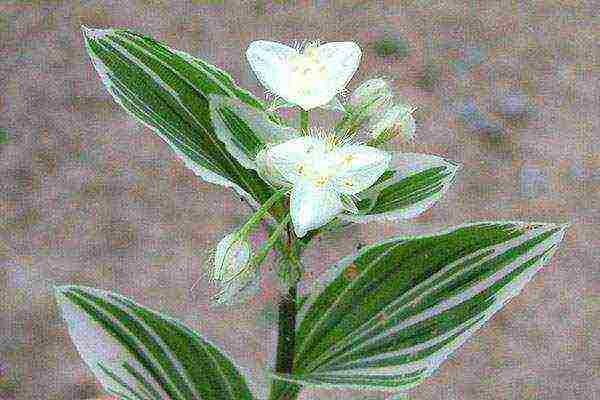
The culture is characterized by rapid growth, therefore, additional feeding must be included in the care of room tradescantia at home. They are carried out in the summer months and in the spring with an interval of 10-14 days. Ready-made complex fertilizers for indoor crops are quite suitable for the plant, but you will have to choose a special approach to variegated forms. From the abundance of organic matter, such indoor tradescantia actively grows foliage, however, it can lose the decorative variegated color of greenery.
Pruning, reproduction and transplantation of room tradescantia
Fast growth and formation of beautiful ampelous shoots is an important advantage of Tradescantia. But in order for the indoor tradescantia, as in the photo, to retain its shape and attractiveness, the stems and the central part of the plant do not look bare, the plant needs to be often pinched and updated, forcing it to bush as actively as possible.
 You can cut off growing stems throughout the warm season. The apical cuttings used for vegetative propagation of Tradescantia root perfectly in ordinary water, after which several pieces are planted in their own pots or serve to rejuvenate the mother plant. If it is decided to use the stem segments as seedlings, their length should be at least 5 cm.
You can cut off growing stems throughout the warm season. The apical cuttings used for vegetative propagation of Tradescantia root perfectly in ordinary water, after which several pieces are planted in their own pots or serve to rejuvenate the mother plant. If it is decided to use the stem segments as seedlings, their length should be at least 5 cm.
With proper home care, Tradescantia, as in the photo, recovers very quickly after pruning, and the seedlings turn into adult fluffy specimens that bloom in the second or third year.
For planting new and replanting existing tradescantia, you should not take an overly nutritious, organic-rich soil, in which the plants quickly "fatten", refuse to bloom.
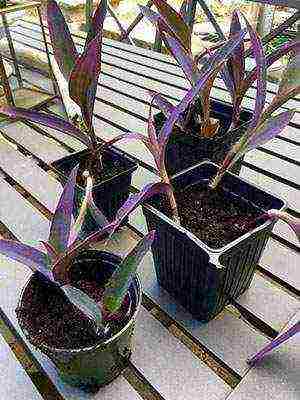 It is best for an ampelous "American" to purchase a ready-made substrate for indoor plants or mix leafy and turfy ground in equal proportions, adding sand and a little peat for looseness. A powerful drainage layer is made at the bottom of the pot. The transplant of tradescantia at home care is carried out in the spring as the bush ages and the root system grows.
It is best for an ampelous "American" to purchase a ready-made substrate for indoor plants or mix leafy and turfy ground in equal proportions, adding sand and a little peat for looseness. A powerful drainage layer is made at the bottom of the pot. The transplant of tradescantia at home care is carried out in the spring as the bush ages and the root system grows.
Growing and caring for garden tradescantia
In indoor conditions, ampelous species are most popular with florists. And garden tradescantia are actively flowering perennials that form dense caps of greenery due to erect and lodging shoots with a length of 20 to 50 cm.
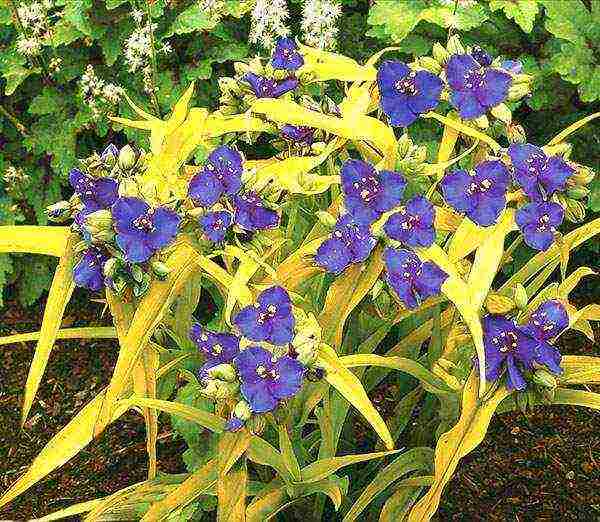 The most common garden tradescantia, as in the photo, are considered hybrid plants, combined into a single species "Virginia tradescantia". They are:
The most common garden tradescantia, as in the photo, are considered hybrid plants, combined into a single species "Virginia tradescantia". They are:
- grow rapidly in a moderately warm European summer;
- bloom profusely, giving a lot of white, purple, blue and bright blue flowers;
- stand out against the background of other plants with a variety of foliage colors from rich green and gray to purple and even yellow.
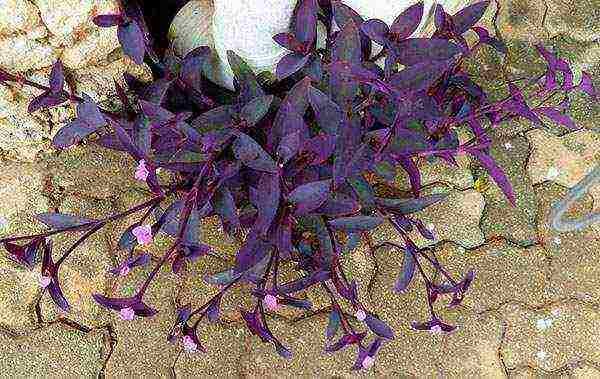 Due to the different growing conditions, caring for a garden tradescantia differs from the care that plants receive at home.
Due to the different growing conditions, caring for a garden tradescantia differs from the care that plants receive at home.
Flowers planted on flower beds and borders cannot be transferred or rearranged to another place if their delicate leaves are in deep shade or in the July sun. Therefore, the site for the garden tradescantia is chosen very carefully.
It is optimal if the plant finds a place in partial shade, where the ground will keep moisture for a long time, but at the same time be ventilated. All Tradescantia are extremely drought tolerant. It is important to consider this not only when planting a garden tradescantia, in the photo, but also when leaving on it.
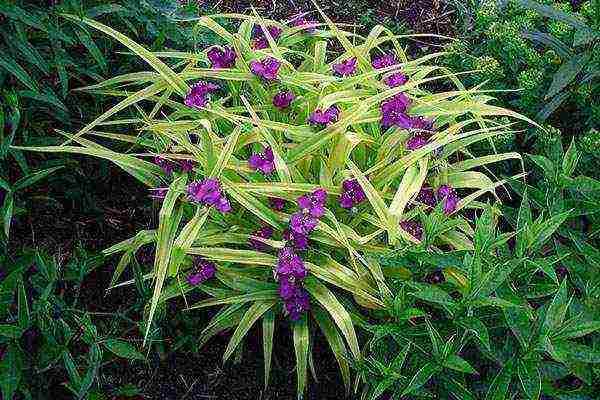 Before planting the plant in the ground, fertilize the soil with a full dose of a complex mineral agent. Then feeding is carried out with a liquid composition every 10 days. The soil under the flowers is moistened in the morning or evening hours, when there is no threat of sunburn for the leaves of the plant.
Before planting the plant in the ground, fertilize the soil with a full dose of a complex mineral agent. Then feeding is carried out with a liquid composition every 10 days. The soil under the flowers is moistened in the morning or evening hours, when there is no threat of sunburn for the leaves of the plant.
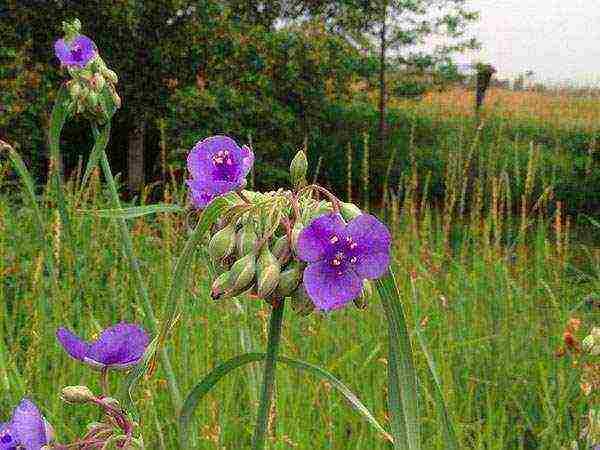 In the middle lane, garden tradescantia survive even harsh winters, for which they are either covered or simply cut off the entire aerial part of the plant. This is a fundamental difference in the cultivation of garden varieties compared to caring for Tradescantia at home. With the onset of spring and the awakening of dormant buds, new fresh shoots appear above the ground.
In the middle lane, garden tradescantia survive even harsh winters, for which they are either covered or simply cut off the entire aerial part of the plant. This is a fundamental difference in the cultivation of garden varieties compared to caring for Tradescantia at home. With the onset of spring and the awakening of dormant buds, new fresh shoots appear above the ground.
Spring is a very good time for breeding garden tradescantia. This is done by dividing an adult bush. During spring and the first half of summer, young plants can be obtained by cuttings. The apical parts of the shoots with 2-3 internodes are carefully cut and rooted in the greenhouse. Roots are formed within 15–20 days, and young Tradescantia can be planted in a permanent place.
Tradescantia care video


